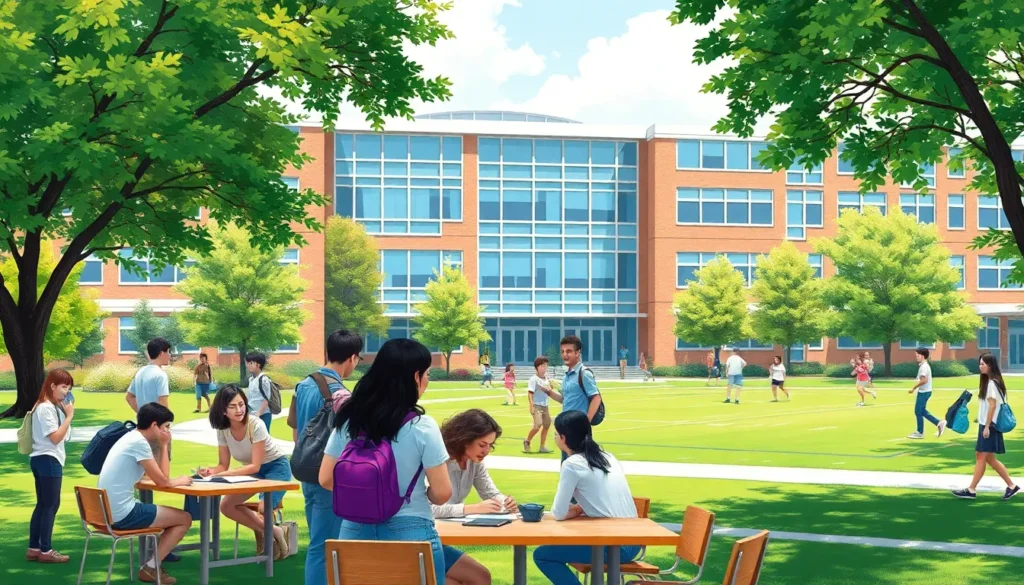When it comes to high school, most students dream of a place where knowledge reigns supreme and the cafeteria food is at least edible. Enter the U.S. News & World Report’s Best High Schools rankings, where academic excellence meets a dash of competitive spirit. These rankings don’t just highlight the crème de la crème of education; they also serve as a guiding light for parents and students alike, helping them navigate the often murky waters of school choice.
Table of Contents
ToggleOverview of US News and World Report Best High Schools
U.S. News & World Report ranks high schools based on criteria that reflect academic performance, educational quality, and student outcomes. Their methodology includes measuring standardized test scores, the performance of disadvantaged students, and graduation rates. Schools achieving high rankings demonstrate a commitment to providing rigorous educational experiences.
Top high schools generally exhibit strong Advanced Placement (AP) participation rates. AP courses allow students to earn college credit, showcasing their readiness for higher education. Many schools also emphasize college readiness, as evidenced by high rates of students enrolling in institutions of higher learning.
This annual ranking releases a comprehensive list of schools across the country, allowing comparisons between institutions. Each school receives a rank that encompasses overall performance and various categories, facilitating easier navigation for parents and students. Rankings feature specific categories, such as Best Charter Schools and Best Magnet Schools, addressing diverse education preferences.
Responsible use of these rankings helps families assess their options. By analyzing metrics outlined by U.S. News, parents can match a school’s attributes with their children’s strengths and interests. These rankings serve as a valuable resource for understanding how schools educate students and prepare them for the future.
Updated rankings are released every year, reflecting ongoing changes in the educational landscape. As educational systems adapt, so do the metrics used, ensuring the rankings remain relevant and informative. Considering these factors, the U.S. News & World Report rankings provide critical insights into the effectiveness and resources available at high schools nationwide.
Key Criteria for Ranking

U.S. News & World Report bases its high school rankings on several key criteria that reflect overall educational quality and student outcomes.
Academic Performance
Academic performance stands as a critical factor in determining rankings. Schools receive scores based on standardized test results in math and reading. Performance metrics also consider how well students prepare for advanced coursework, particularly Advanced Placement (AP) tests. High-ranking schools typically exhibit higher scores, often reflecting strong teaching practices and curriculum rigor. Graduation rates further influence overall academic performance scores, highlighting schools committed to student success. Schools demonstrating excellence in these areas frequently make the top of the list.
College Readiness
College readiness represents another significant criterion. U.S. News measures this through metrics like AP participation rates and the number of students scoring three or higher on AP exams. Schools promoting a robust AP program typically equip their students with skills necessary for higher education. Enrollment data of students in college preparatory courses also plays a role in determining readiness. High rankings often correlate with strong college acceptance rates, indicating effective guidance and support mechanisms within the school.
Social Equity
Social equity emphasizes fairness in educational opportunities. Rankings assess how well schools support disadvantaged students, looking at the performance of these groups compared to their peers. Metrics include success in closing achievement gaps and providing resources for lower-income students. Schools that excel in promoting social equity frequently achieve higher rankings, as they prioritize diversity and inclusion, ensuring all students receive quality education. Efforts to improve access to advanced coursework also indicate a school’s commitment to equity in education.
Highlights of the Top Ranked Schools
Top-ranked schools on the U.S. News & World Report list demonstrate exceptional academic achievements and distinctive educational offerings. These institutions stand out for their commitment to student success and holistic development.
School Profiles
Prominent high schools such as Thomas Jefferson High School for Science and Technology in Virginia and Academic Magnet High School in South Carolina consistently excel in standardized assessments. They integrate rigorous academic curriculums with innovative teaching methods. These schools frequently report impressive graduation rates, often reaching 95% and above. Their diverse student bodies further enrich the learning environment, fostering collaboration among students from various backgrounds.
Unique Programs and Features
Top institutions offer unique programs designed to enhance educational experiences. Advanced Placement courses remain a significant focus, allowing students to earn college credit while still in high school. Some schools implement specialized STEM programs, creating pathways for careers in technology and engineering. Extracurricular activities such as robotics clubs and debate teams complement academic pursuits, encouraging leadership skills and teamwork among students. These distinctive features contribute to the overall appeal and effectiveness of these esteemed schools.
Impact on Students and Communities
High-ranking schools significantly influence both students and their surrounding communities. Enhanced academic performance often leads to increased student motivation and lower dropout rates. Students in these institutions commonly benefit from advanced coursework and access to extracurricular activities. Studies indicate that learning environments fostering engagement contribute to improved social and emotional well-being for students.
Communities also reap advantages from successful high schools. Strong educational institutions attract families, leading to population growth and increased local investment. Economic development frequently correlates with robust school systems, creating a cycle of prosperity. For instance, communities housing top-ranked schools often see a rise in property values due to demand for housing in quality school districts.
Diversity within high-performing schools further enriches student experiences. Exposure to different perspectives cultivates cultural awareness and prepares students for a globalized world. Strong programs focusing on social equity help bridge achievement gaps, promoting inclusiveness.
Schools that excel in supporting disadvantaged students demonstrate a commitment to equitable resources. Programs targeting underrepresented populations often reflect positively on a school’s overall ranking. As a result, students from various backgrounds find environments where they can thrive academically and socially.
Parental involvement also increases in high-performing schools. Engaged families contribute positively to school activities, fostering a sense of community. Involvement can lead to better support systems for students and enhance educational outcomes.
The impact of high-ranked schools extends beyond academics. Their influence shapes communities, drives economic growth, and fosters a supportive environment for all students.
The U.S. News & World Report’s Best High Schools rankings serve as a valuable resource for families navigating educational choices. These rankings highlight schools that excel in academic performance and college readiness while promoting social equity. By focusing on critical metrics like standardized test scores and AP participation rates, they provide insights into the effectiveness of educational institutions.
High-ranking schools not only prepare students for academic success but also foster environments that support diversity and inclusion. As families explore their options, understanding these rankings can lead to informed decisions that align with their children’s unique strengths and aspirations. Ultimately, the impact of these schools extends beyond academics, shaping communities and future leaders.




